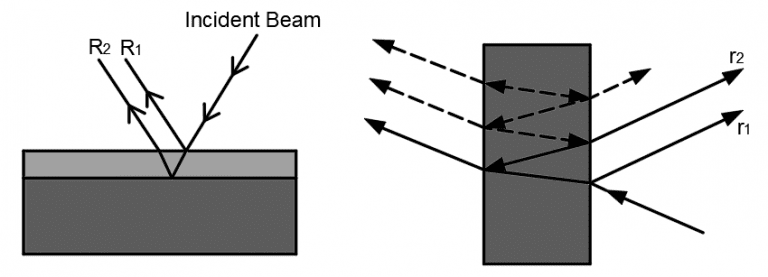AR Coatings and BBAR Coatings
Introduction
The world of optics is intricately entwined with the management of light, and among the crucial innovations is the Anti-Reflection (AR) coating. Fresnel reflection, responsible for a 4% light loss at each interface between air and an uncoated glass substrate, underscores the need for such coatings. These reflections, if unmitigated, curtail overall light transmission to 92%, impacting a myriad of applications. The significance of AR coatings becomes apparent in their ability to enhance system throughput, mitigating hazards stemming from reflections that can lead to laser-induced damage, destabilize laser systems, and generate unwanted ghost images. This essay delves into the principles, design considerations, and applications of AR coatings, unraveling the science behind their effectiveness in minimizing reflections and optimizing optical system performance. Within this landscape, dielectric coatings and multi-layer structures play a pivotal role in tailoring the performance characteristics of these coatings, allowing for precision in coating design to address specific wavelength ranges. The use of fused silica as a substrate material further contributes to the overall efficacy, providing a durable and transparent base for these optical coatings.
Fresnel Reflection and Its Consequences:
- Approximately 4% of light is reflected at each interface when light passes from air through an uncoated glass substrate due to Fresnel reflection.
- This reflection reduces overall light transmission to 92%, impacting various applications.
Importance of AR Coatings:
- AR coatings are applied to optical surfaces to increase system throughput and reduce hazards caused by reflections.
- Excess reflected light can lead to laser-induced damage, destabilize laser systems, and create ghost images.
Principle of AR Coatings:
- AR coatings are designed to introduce a 180° relative phase shift between beams reflected at the upper and lower boundaries of a thin film.
- Destructive interference between the reflected beams leads to their cancellation before exiting the surface.
Optical Thickness and Design Wavelength:
- The optical thickness of the coating must be an odd integer multiple of the design wavelength (DWL) for effective interference.
- The refractive indices of the incident medium and substrate are used to find the index of refraction for complete cancellation of reflected beams.
Limitations and Characteristics:
- Reflectivity increases rapidly as the wavelength moves away from the DWL.
- AR coatings are most effective at or very close to the intended DWL.
- Transmission curves of AR coatings are semi-periodic, reaching local minima at harmonics of the DWL.
Composition of AR Coatings:
- Simple AR coatings can consist of a single layer with a specific thickness, but more layers may be added for bandwidth adjustment.
- Multilayer coatings may compensate for different angles of incidence but are more complex.
Reflectivity and Tolerances:
- AR coatings aim to achieve reflectivity significantly less than 0.25%, with standard coatings specified to have <0.25% reflectivity at the DWL.
- Tolerances allow for small shifts in the DWL without significantly affecting coating performance.
- Understanding these principles and characteristics is crucial for designing and implementing effective AR coatings in optical systems, contributing to improved performance, and reduced unwanted reflections.

Broadband Anti-Reflection (BBAR) Coating
- BBAR coatings are designed to enhance transmission over a broader wavelength range compared to traditional AR coatings.
- They are particularly useful with light sources and lasers that emit a broad spectrum or have multiple harmonic generations.
- While BBAR coatings may not achieve reflectivity values as low as traditional AR coatings, they offer increased versatility due to their wider transmission band.
- This versatility is beneficial for applications involving broad-spectrum light sources and lasers with diverse wavelengths.
- BBAR coatings are commonly applied to transmissible optical components such as lenses and windows to improve their performance over a wide range of wavelengths.
- They find specific use in systems where a single narrow-band AR coating might not be suitable.
- AR coatings, including BBAR coatings, are applied to laser crystals and nonlinear crystals to minimize reflections.
- Fresnel reflections occur at the interface between air and the crystal, and these reflections can impact the performance of lasers and nonlinear optical processes.
- BBAR coatings are chosen for their ability to provide improved performance over a wide range of wavelengths.
- The trade-off is that the reflectivity values may not be as low as those achieved with coatings optimized for a specific wavelength.
- BBAR coatings are particularly relevant in laser systems that involve multiple-harmonic generation, where different wavelengths are present.
UV (250-380nm) |
Our UV broadband anti-reflection coating R(avg) ≤ 1% @ 250 – 425nm |
VIS (380-750nm) |
Our visible broadband anti-reflection coating R(avg) ≤ 0.5% @ 350 – 750nm |
NIR (750-900nm) |
Our NIR broadband anti-reflection coating R(avg) ≤ 0.7% @ 750 – 900nm |
SWIR (900-1700m) |
Our SWIR broadband anti-reflection coating R(avg) ≤ 1.0% @ 900 – 1700nm |
Conclusion
In the ever-evolving landscape of optical engineering, understanding and implementing the principles and characteristics of Anti-Reflection coatings, including the versatile Broadband Anti-Reflection (BBAR) coatings, prove paramount for achieving enhanced performance, reduced unwanted reflections, and the seamless functionality of optical systems across diverse applications. The considerations for coating design, whether involving single or multi-layer structures, along with the implementation of ion-assisted techniques, play a crucial role in achieving desired optical properties. The ability to mitigate reflection loss through destructive interference, particularly in laser applications where a specific laser line is critical, highlights the importance of tailored coatings. Moreover, anti-glare properties, influenced by factors such as refractive index and wavelength range, are essential for applications requiring optimal visibility. The average reflectance across different coatings, especially in the context of dielectric coatings, showcases the advancements made in minimizing reflection and optimizing light transmission. As the field advances, these key elements contribute to the ongoing success of optical coatings in various industries.
Related Content
GREAT ARTICLE!
Share this article to gain insights from your connections!

